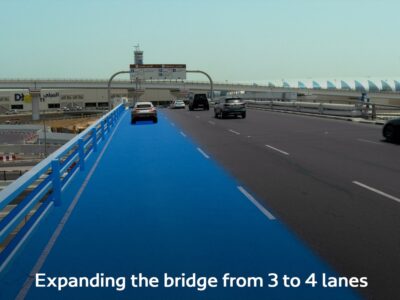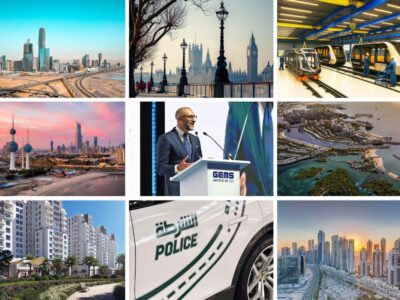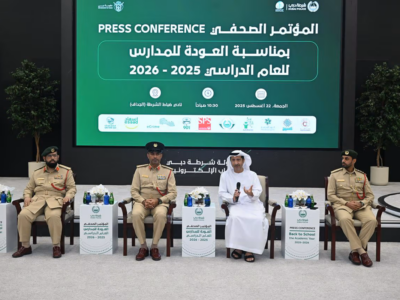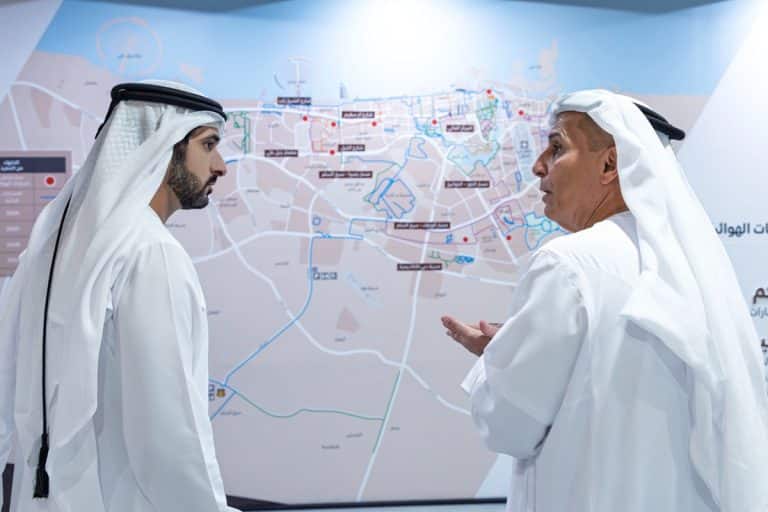Dubai will be transformed with a new transport plan to massively expand the road network, slash journey times, introduce trackless trams and create more dedicated bus and tram lanes in the city.
Sheikh Hamdan bin Mohammed bin Rashid Al Maktoum, Crown Prince of Dubai, Deputy Prime Minister, Minister of Defence, and Chairman of The Executive Council of Dubai reviewed the transformative initiatives of Dubai’s Roads and Transport Authority (RTA) aimed at advancing urban mobility and infrastructure.
These include the AED16bn ($4.4bn) 2024-2027 Main Roads Development Plan, which will add 22 projects across Dubai’s expanding road network, benefiting more than 6 million people and supporting Dubai’s comprehensive development plans.
Sheikh Hamdan bin Mohammed also reviewed a series of projects and initiatives in autonomous transport and the integration of artificial intelligence (AI) in traffic management focused on enhancing mobility in Dubai
During his visit to RTA’s headquarters, Sheikh Hamdan was welcomed by Mattar Al Tayer, Director-General, Chairman of the Board of Executive Directors of RTA, and several senior RTA officials.
Dubai roads plan
Sheikh Hamdan reviewed a presentation illustrating the growth in public transport users, which currently serves 2.2m riders daily, as well as the development of the road network, bridges, and cycling tracks in Dubai from 2006 to the present.
The road network expanded from 8,715 lane-kilometres to 18,990 lane-kilometres, marking a 117 per cent increase.
The number of lanes across Dubai Creek rose from 16 to 61, a 281 per cent increase, while vehicle bridges and tunnels grew from 129 to 1,070, marking a 729 per cent rise.
Pedestrian bridges and tunnels also increased from 26 to 129, encompassing Dubai Metro and Dubai Tram bridges and tunnels, a 396 per cent growth. Cycling tracks extended from 9km to 557km, a remarkable 6,088 per cent increase.
RTA plans to further expand cycling tracks to connect coastal areas like Jumeirah, Al Sufouh, and Marina with external tracks in Al Qudra, Saih Al Salam, and Nad Al Sheba via Al Barsha and Dubai Hills.
Dubai traffic data
Sheikh Hamdan received a briefing from Mattar Al Tayer on Dubai’s traffic indicators. The number of vehicles in Dubai during daytime hours has reached 3.5m, with a 10 per cent increase in registered vehicles over the past two years, compared to a global average of 2 to 4 per cent.
Population growth is projected at 3.6 per cent annually until 2030. Despite significant traffic volume growth, Dubai ranks high on the global journey time index.
According to the 2023 TomTom Global Traffic Index, Dubai achieved a journey time of 12 minutes and 50 seconds for a 10 km trip within the central business district, compared to 16 minutes and 50 seconds in Singapore, 19 minutes in Montreal, 21 minutes in Sydney, 22 minutes in Berlin, and 36 minutes in London.
Dubai road projects
Sheikh Hamdan was briefed on RTA’s roads project plans, which include 22 projects, including the Latifa bint Hamdan Street development set to commence next year.
This project covers 12.200km from its intersection with Al Khail Road to Emirates Road, encompassing 8,1km of bridges.
Serving more than 1m residents, the project will add capacity for approximately 16,000 vehicles per hour in both directions and reduce travel time by 15–20 per cent.
The plan also includes the Meydan Road development project, which will involve 10.6km of roads, 3.3km of bridges, and three tunnels totalling 1.5km, benefiting around 1m residents.
It is expected to add capacity for 22,000 vehicles per hour in both directions and reduce travel time from Umm Suqeim Street to the extension of Meydan Street to just four minutes.
Sheikh Hamdan reviewed the development plans for Al Mustaqbal Street and Trade Centre Roundabout. The project includes the construction of bridges and tunnels totalling 6.2km, which will increase road capacity from 9,000 to 12,000 vehicles per hour, a 30 per cent increase.
It will also reduce travel time from eight minutes to three minutes and 30 seconds, benefiting over half a million residents and visitors.
RTA has awarded the contract for the Trade Centre Roundabout development project, which includes the construction of five bridges totalling 5km to ensure free-flowing traffic in all directions.
The roundabout will be converted into a surface-level intersection controlled by traffic signals to improve traffic flow, reducing delays from 12 minutes to just 90 seconds.
By the end of this year, RTA will also award the contract for the Al Mustaqbal Street development project. Sheikh Hamdan was also briefed on the development plans for Umm Suqeim and Al Qudra Streets, covering a 16km stretch from the Jumeirah Street intersection to Emirates Road.
The project will involve the development of four intersections, including 2.5km of bridges and 2km of tunnels.
This will increase road capacity from 8,400 to 12,600 vehicles per hour and reduce travel time from 46 minutes to just 11 minutes, benefiting over 800,000 residents.
Sheikh Hamdan was also briefed on the Al Fay Street Development Project, one of the key strategic corridors in the emirate, extending from Al Khail Road at its intersection with Sheikh Mohammed bin Zayed Road, passing through Sheikh Zayed bin Hamdan Al Nahyan Street up to the Emirates Road.
The project includes 12.9km of road construction and the development of five intersections, with 13.5km of bridges. This will provide additional capacity for approximately 64,400 vehicles per hour, benefiting around 600,000 residents.
Sheikh Hamdan also reviewed the Al Safa Street development project, which stretches from Sheikh Zayed Road to Al Wasl Road.
The project includes the construction of 2.1km of tunnels, including a two-lane tunnel providing direct access from Al Safa Street to the City Walk project, as well as 650m of bridges.
These upgrades will increase the street’s capacity from 6,800 to 9,400 vehicles per hour and reduce travel time from 20 minutes to just two minutes, benefiting approximately 358,000 residents.
Sheikh Hamdan bin Mohammed also reviewed projects and initiatives in autonomous transport and the integration of artificial intelligence (AI) in traffic management to enhance mobility in Dubai.

Trackless tram in Dubai
Furthermore, Sheikh Hamdan reviewed RTA’s plans to expand the Dubai Tram network with a study on deploying trackless tram systems at eight locations across Dubai.
This advanced, self-driving tram system operates on virtual tracks, using camera-guided painted lines on dedicated lanes. Powered by electricity, it is eco-friendly, with lower costs and faster construction compared to traditional trams.
Each tram has three carriages with a capacity of 300 passengers, a top speed of 70kmph, and an operational speed of 25 to 60kmph. A single charge allows the tram to travel up to 100km.
His Highness also reviewed the operational achievements of the Dubai Tram, which will mark its 10th anniversary on November 11, 2024.
Since its launch, the tram has completed 950,000 journeys, served 60m passengers, and achieved an 850 per cent increase in ridership since opening. The tram also maintains a high punctuality rate of 99.9 per cent.

Dedicated bus and taxi lanes in Dubai
Sheikh Hamdan was briefed on RTA’s plans to extend dedicated bus and taxi Lanes in 2025 and 2026. This extension will add six routes covering 13km, bringing the total length of dedicated lanes to 20km.
These lanes are projected to increase ridership by 10 per cent, improve bus arrival rates by 42 per cent, reduce bus travel time by 41 per cent, encourage public transport use, and alleviate traffic congestion.
The lanes are also designed to support Dubai’s Self-Driving Transport Strategy 2030, with expected economic benefits estimated at AED2.3bn ($626m) over 10 years. These lanes will support autonomous, electric-powered buses.
Sheikh Hamdan was also briefed about an autonomous bus equipped with the latest AI and self-driving technologies to ensure maximum safety.
With a speed of 40kmph, the bus is designed for first and last-mile transport, connecting main transit hubs with final destinations. It has a capacity of 10 to 20 passengers and serves as a practical solution for sustainable urban transport.
Other plans for the Dubai transport network include the Commercial Transport (Logisty) Platform, a digital service developed in partnership with the private sector to enhance commercial transport services for business clients.
The platform manages commercial vehicle fleets, providing on-demand booking and tracking, vehicle and driver verification, and a reliable registration database.
It supports Dubai’s Commercial and Logistics Land Transport Strategy 2030, connecting customers with commercial transport providers.

Smart cycling tracks in Dubai
Sheikh Hamdan reviewed the dedicated cycling tracks network, which spans 557km and supports an estimated 44m cycling trips annually, alongside 2.3m soft mobility trips.
He also attended a presentation on the Smart Cycling Tracks Scanning Initiative, which uses a specially equipped vehicle to scan 120km of cycling tracks within four hours, compared to only 10 kilometres using visual assessment.
This initiative aims to establish preventive, predictive, and proactive maintenance strategies for cycling tracks and their infrastructure, ensuring track quality, enhancing user safety, and promoting sustainability across the cycling network.







